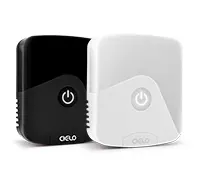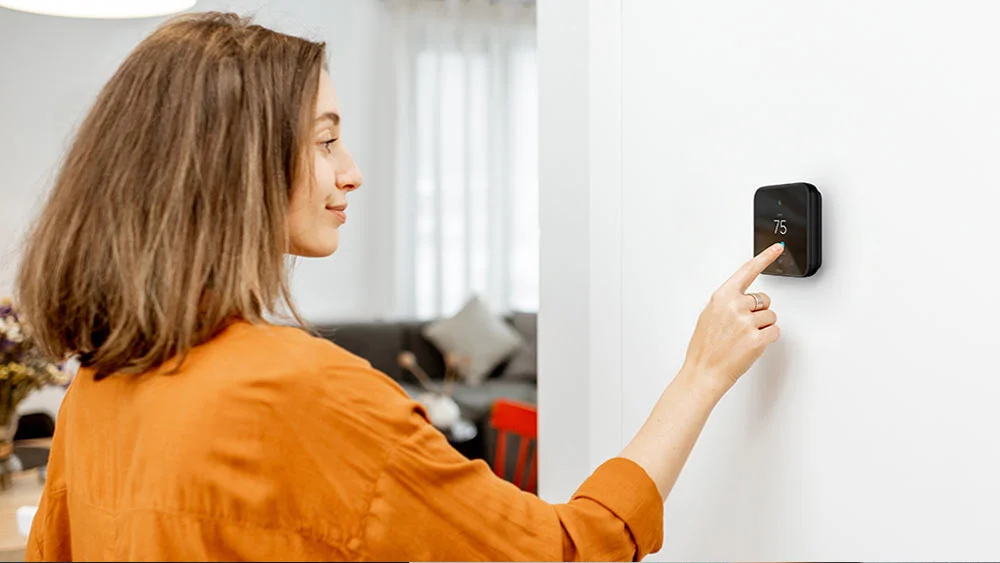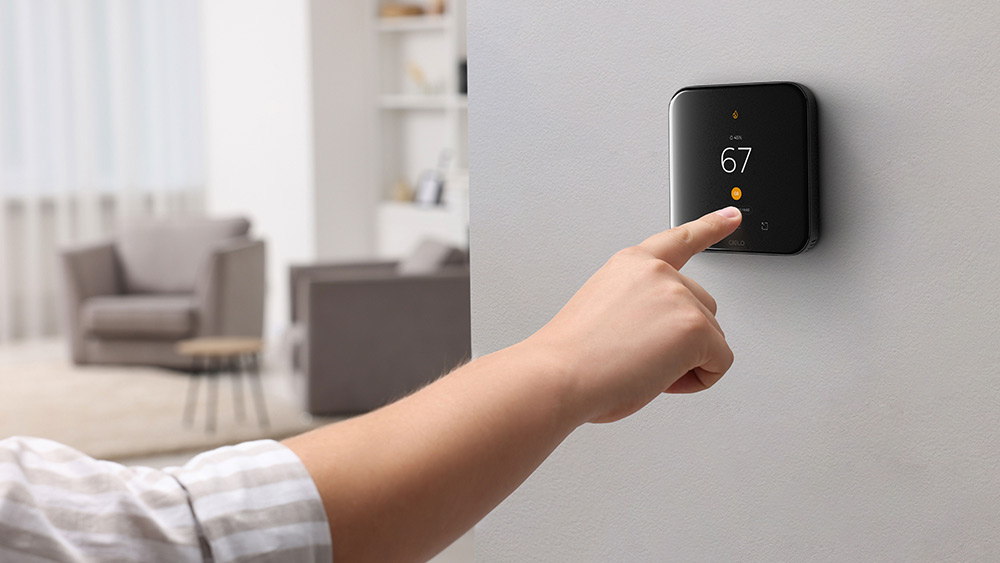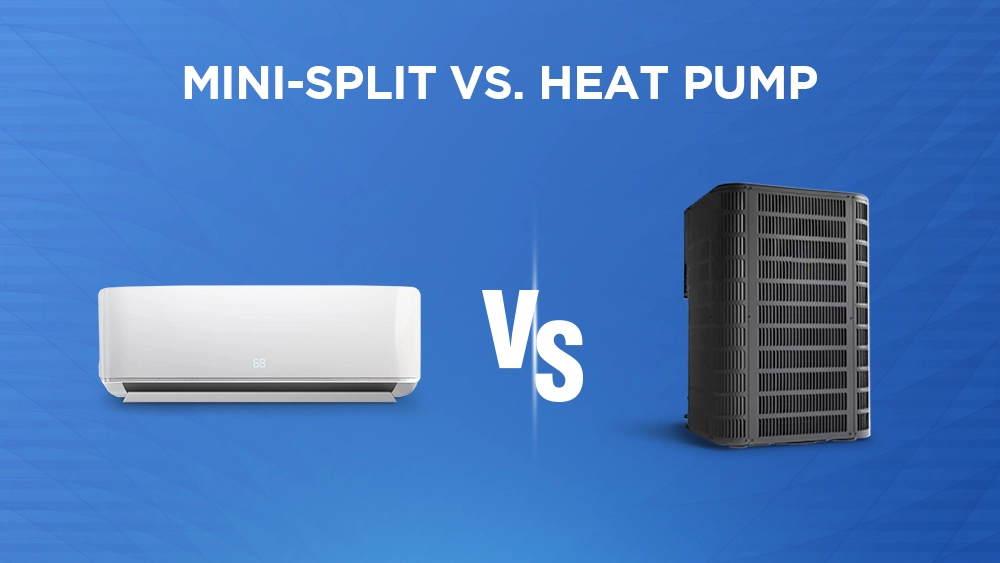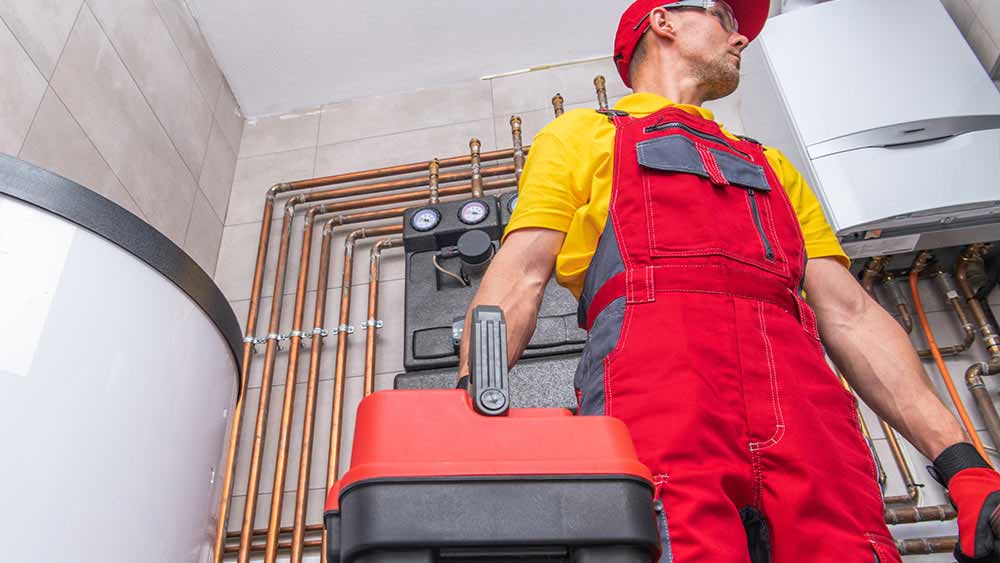
Key Takeaways
- Regular upkeep helps your furnace run efficiently and lowers energy bills.
- DIY furnace maintenance tasks include, replacing filters, vaccuming the blower compartment and cleaning the pilot.
- Hire a pro if you notice issues like soot buildup, short-cycling or irregular pilot flame.
Winter chill demands a reliable and efficient furnace ready to ward off the biting cold. After all, the last thing you need during the freezing weather is your heating system failing to deliver the warmth your home craves. This is why furnace maintenance should be a top priority for you. Not only does regular HVAC maintenance prevent breakdowns and ensure peak efficiency, but it can also save you money on bills.
From checking air filters and flues to inspecting the burners and blowers, this blog explores how to perform various furnace maintenance tasks to ensure that your unit stays running smoothly throughout the colder months.
Signs Your Furnace Requires Maintenance
There are various tell-tale signs when your furnace maintenance is due:
- Sudden high heating bills may be a direct result of dirt buildup in your furnace. This accumulation of debris will adversely affect your furnace performance.
- If your furnace isn’t blowing hot air, it may be due to dirty air filters. Dust and other particles can accumulate on the filter’s surface, making it difficult for air to pass through.
- If you smell any unusual smells coming from your furnace, like rotten eggs, then it likely means you have a gas leak in your furnace. If you smell something burnt, then it might be dust burning or some other electrical issue.
- If your furnace is making loud or unusual noises, it can be unsettling. While some sounds are normal when the burner fires up and air flows through the ductwork, others can indicate a problem. If there are weird noises like banging, whistling, or rumbling, then it’s best to call in a professional to inspect the furnace.
- The pilot light should be blue and steady. If the pilot’s light is yellow or orange and it’s flickering, it signals that the pilot needs a thorough cleaning.
What Does Furnace Maintenance Include?
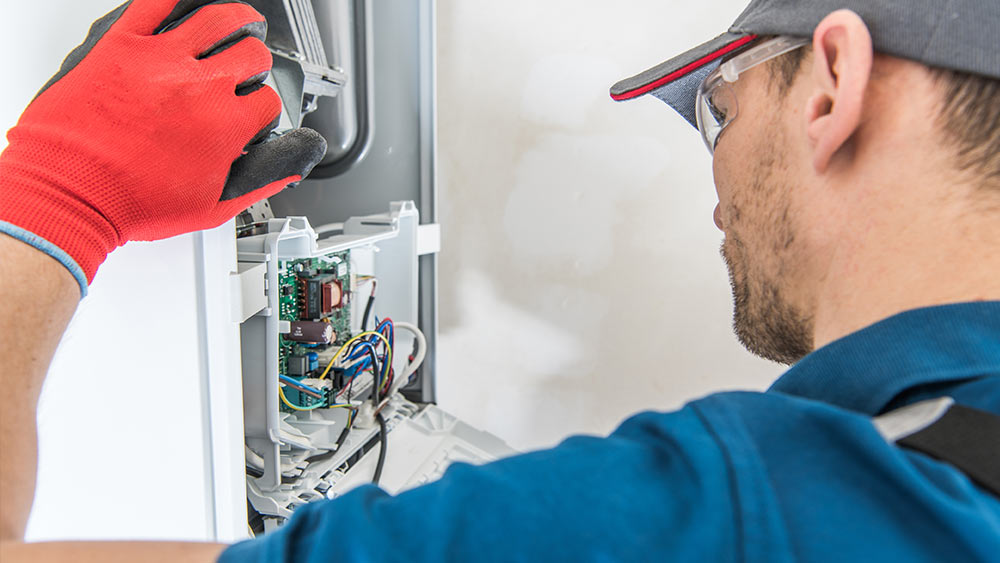
There are two types of furnace inspections. The first type typically occurs after an HVAC contractor has installed a new furnace. This particular inspection is conducted by a third-party inspector, whose main function is to ensure that the installation has been done correctly and in compliance with local building codes. The second type of inspection happens annually to see whether the furnace is running smoothly or if any repairs or adjustments need to be made. However, small tasks such as cleaning filters should be done more frequently.
You can perform basic maintenance during the annual furnace service yourself, but for specific safety and performance benchmarks, you will have to hire a professional. These checks include measuring carbon monoxide levels, assessing the condition of gas line components, verifying satisfactory flue venting, and analyzing safety shut-off. Additionally, they will examine the heat exchanger, flame sensor, and blower motor. The professional inspection will help diagnose and address any potential issues before they translate into bigger issues.
Furnace Maintenance Checklist
Before starting the furnace cleaning process, take the time to read through your manufacturer’s instructions. Safety should be the top priority, so ensure that the furnace is turned off and cooled down completely to prevent any accidental fires.
Related: Home Heating Safety: 15 Top Fire Prevention Tips Every Homeowner Should Know
1. Shut Down Your System
To turn off the power supply, use the red power switchplate, located either at the top of the cellar stairs or near the burner itself. Also, turn off the fuel valve. Depending on whether you have a gas or oil furnace, the fuel shutoff valve is located near the oil tank or on the gas pipe.
2. Open the Combustion Chamber Door
The combustion chamber is where the fuel and air ignite to create heat, carbon soot, water vapor, and carbon dioxide. Over time, you will find soot buildup inside the combustion chamber walls.
Take a small wire brush and scrape off the soot. You can also vacuum the loose materials inside for a thorough cleanup. Inspect the chamber for holes and cracks. Cover them with foil tape.
3. Inspect the Burner Flames
Turn on the power supply and raise the thermostat to inspect the burner flames. They should be even and blue. If the flames are yellow or orange, they are dirty and require a thorough cleaning. Call the HVAC technician to have the burner checked.
Equip your HVAC system with smart features and achieve the perfect balance between comfort & savings.
Learn more
4. Vacuum the Burner and Blower Compartment
Turn off the power switch and gas supply again for this maintenance task. Vacuum the furnace burners. Look for signs of soot inside. It’s a fine, black powder, and its presence indicates poor combustion. Contact your furnace technician to check why there is soot buildup.
After you have cleaned the burner, remove the blower compartment door and vacuum the inside area. Also, look for gaps and cracks. Cover the holes with foil tape and then replace the door.
5. Inspect the Flue Pipe
The flue pipe removes fuel by-products. Check the flue pipe for the right fit and flow. Ensure the safety of your home by checking for any openings in the exhaust flue that may result in carbon monoxide leaks. Pay attention to the area where the flue pipe connects to the furnace. If you find small holes, you can fix them easily with foil tape. However, if the flue is corroded, it will need to be replaced.
In addition, you can maximize your chimney’s efficiency by adjusting the barometric damper on the flue pipe. This will help regulate the flow of air. In older homes with large chimneys, too much air intake can affect efficiency. A professional service can adjust the damper’s weight to address this issue.
6. Check for Gas Leaks
Checking your gas line for leaks is an essential preventative HVAC maintenance task. If you notice any hissing sound or peculiar smell of propane around the gas line, it’s crucial to act fast and shut off the main valve immediately.
7. Change the Air Filter
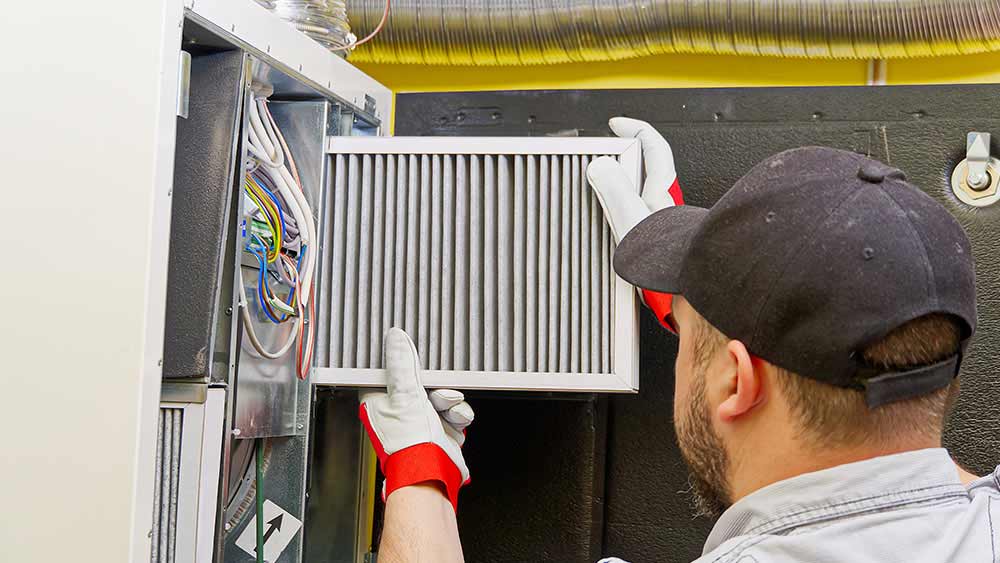
The air filter removes pollutants and allergens before they reach your home, helping to improve your indoor air quality and maintain the efficiency of your furnace. It’s best to replace the filter every three months or more regularly if you have pets.
To change the filter, find the filter housing. It is usually in the blower compartment. Remove the old filter and insert the new one. Then, close the compartment.
8. Replace the Oil Filter
For oil furnace maintenance, look for the oil filter. It is designed to protect against small impurities that can clog the oil burner nozzle and create a potential misfire that can shut down the entire unit.
To replace the filter, follow these simple steps: close the oil valve, remove the old filter, and replace it with a new one. Remember to set aside the used filter for proper disposal, adhering to local hazardous-waste regulations.
9. Clean the Furnace Pilot
A dirty pilot can cause your furnace to give false readings. To keep your furnace running smoothly, blow dust from the pilot with a drinking straw to clear it.
10. Dust the Hot Surface Igniter
Hot surface igniters have become the ignition system for modern furnaces, replacing pilot lights. To effectively clean the hot surface igniter and remove any dust, you can simply blow air through a straw.
11. Clean the Flame Sensor
If you notice your furnace is not lighting up, then the flame sensor could be covered in residue. Don’t worry, fixing this is easy. Just gently remove the sensor from its bracket and give it a quick clean with a fine emery cloth. Then, simply put it back into its bracket.
12. Inspect the Drive Belt
Maintain your heating system by regularly adjusting or replacing the belts on belt-driven blowers. Check the drive belt for any cracks or frayed areas. When installing a new belt, make sure to adjust the tension so that it deflects between 1/2 to 3/4 inches.
13. Lubricate Bearings if Necessary
Older furnaces have two motor bearings and two blower shaft bearings that require annual oiling for effective working. For oiling, remove the oil cap and apply two to three drops of lightweight machine oil to each bearing. Make sure not to overlubricate. Finish by putting the caps back on.
14. Adjust Dampers if Necessary
If your heating ducts also serve as air conditioning ducts, it’s important to adjust the HVAC dampers for the changing seasons properly. Look for marked seasonal settings to make this process easier.
For two-story homes, it’s common to have separate supply trunks for upstairs and downstairs. To optimize the distribution of warm air downstairs during winter or cool air upstairs during summer, simply adjust the damper handle on each supply trunk.
15. Seal Leaky Air Ducts
As a homeowner, it’s important to take necessary precautions to achieve energy efficiency and safety in your home. One crucial step is to seal leaky ducts, especially return air ducts, with special metal tape or high-temperature silicone. This not only improves your HVAC system’s efficiency but also prevents indoor air pollution, which can lead to various health issues. After sealing the ducts, a back-drafting test is recommended to ensure the combustion gases are properly vented out. This test involves adjusting the thermostat so the burners come on and holding a smoking stick of incense beside the draft hood.
Also, remember to inspect the exhaust vent pipes on your furnace for any signs of corrosion, like a white powdery residue. If you notice it, then it’s time to call in a professional to fix the problem.
16. Check the Controls and Safety
Furnaces have built-in triggers to prevent dangerous malfunctions and overloads. During your inspection, check the controls and safeties to ensure they don’t disrupt other components. For example, the furnace’s limit switch cuts off the gas if heat or flames are detected outside the burner chamber. Some furnaces display error messages, and they usually won’t restart automatically after a safety trigger; they need a manual reset.
17. Calibrate Your Thermostat
To ensure your thermostat accurately reflects the temperature in your home, it’s essential to calibrate it. You will have to follow the guidelines in the user manual for that.
18. Tighten the Panels
Make sure that your furnace panels are tightly secured to reduce any jostlings that make rattling noises or reduce efficiency. Furthermore, if your front panel doesn’t close properly, then there could be a threat of carbon monoxide poisoning.
When Should You Hire a Pro?
Below are some of the signs that something is amiss with your furnace, and it’s time to bring in a furnace technician.
- Soot Build-up: Excessive soot buildup in the combustion chamber is a clear sign that something is not working as it should. If you happen to notice this problem while cleaning out your furnace or boiler, do not ignore it. Soot buildup usually indicates that your burners need to be adjusted or that your heat exchanger requires replacement. In order to avoid potentially dangerous consequences such as carbon monoxide leaks, it is critical to call in a professional to diagnose and fix the problem as soon as possible. Trying to fix this problem yourself without proper training and equipment can lead to injuries or further damage to your system.
- Short-cycling: If you’ve noticed that your furnace is running for brief periods and then shutting off, you could be experiencing a short-cycling issue. This problem can stem from a variety of issues, such as a malfunctioning thermostat or an overheating exchanger. Although it may be tempting to try and tackle the issue on your own, it’s best to enlist the help of a professional to diagnose and solve the problem.
- Irregular pilot flame: The pilot flame should burn blue and evenly to ensure optimal efficiency. However, if you encounter a yellow, irregular flame in your furnace, it may indicate a malfunctioning system. Generally, this could mean that your burners are dirty or your heat exchanger is cracked. It is essential to contact a professional to investigate the situation since this kind of job is potentially hazardous.
- Testing your fuel efficiency: If you doubt whether your furnace is efficient, a professional can help check and test your system’s AFUE (Annual Fuel Utilization Efficiency).
Related: The Ultimate Furnace Replacement Guide
Benefits of Furnace Maintenance
Regular furnace maintenance goes beyond keeping your home warm and comfortable. This essential service is necessary to avoid potential hazards such as carbon monoxide leaks or furnace malfunction.
- Furnace tune-ups can ensure that your furnace is operating efficiently. Over time, soot and debris can accumulate and cause your furnace to work harder than necessary, increasing your energy bills.
- Furnaces last an average of 15-20 years. Regular upkeep can extend the life of your furnace and catch any potential issues before they turn into major breakdowns.
- One of the benefits of a furnace maintenance service is that it can validate your furnace’s warranty. Should your furnace need repairs, having a valid warranty can save you a significant amount of money.
- Cleaning and replacing your furnace filters according to a proper schedule can help improve your indoor air quality by preventing dust and debris from entering your home.
Furnace Maintenance FAQs
Here are a few common queries regarding your oil or gas furnace maintenance process.
How Often Should Furnace Be Cleaned?
It’s important to schedule your annual furnace maintenance once a year, preferably in the fall season, before the chill fully sets in. However, some of the smaller tasks, such as cleaning your filters and keeping the area around the vents clear, should be done every 1-3 months.
How Long Does It Take to Clean a Furnace?
A full furnace clean-up takes about 1 to 2 hours. Tasks such as cleaning and replacing the filters take about less than 5 minutes to complete.
How Much Is Professional Furnace Cleaning Cost?
Furnace cleaning is an essential aspect of home maintenance. The average furnace maintenance cost for cleaning is roughly $150, ranging between $70 to $400, depending on various factors such as the furnace type, size, and location in your home. Other factors, like the duration since your last furnace cleaning and the level of cleaning, also impact the overall cost. Generally, an electric and gas furnace cleaning will have a more reasonable price, starting at around $60, while oil systems are more expensive to clean.
Cleaning Your Furnace For Efficient Performance
Keeping your furnace in good condition is essential for effective heating. Regardless of whether you own a new furnace or one that has been in your home for a while, taking the time to perform basic maintenance, like cleaning the filter, can make all the difference in your furnace’s performance and energy bills. Before you start your furnace cleaning project, always turn off the electrical power and fuel supply. It is also vital to have the right tools and spare parts on hand to complete the job successfully. In case you are in doubt at any point, it’s best to consult a professional.


